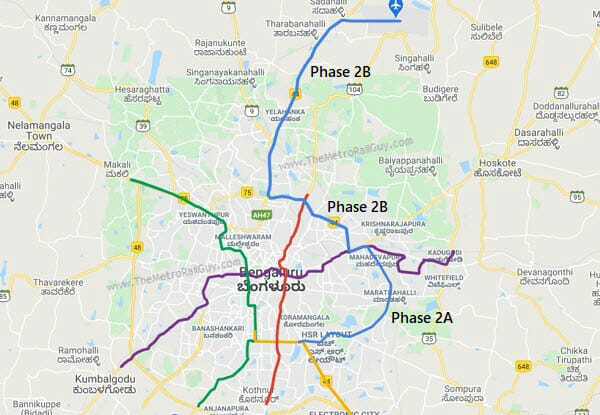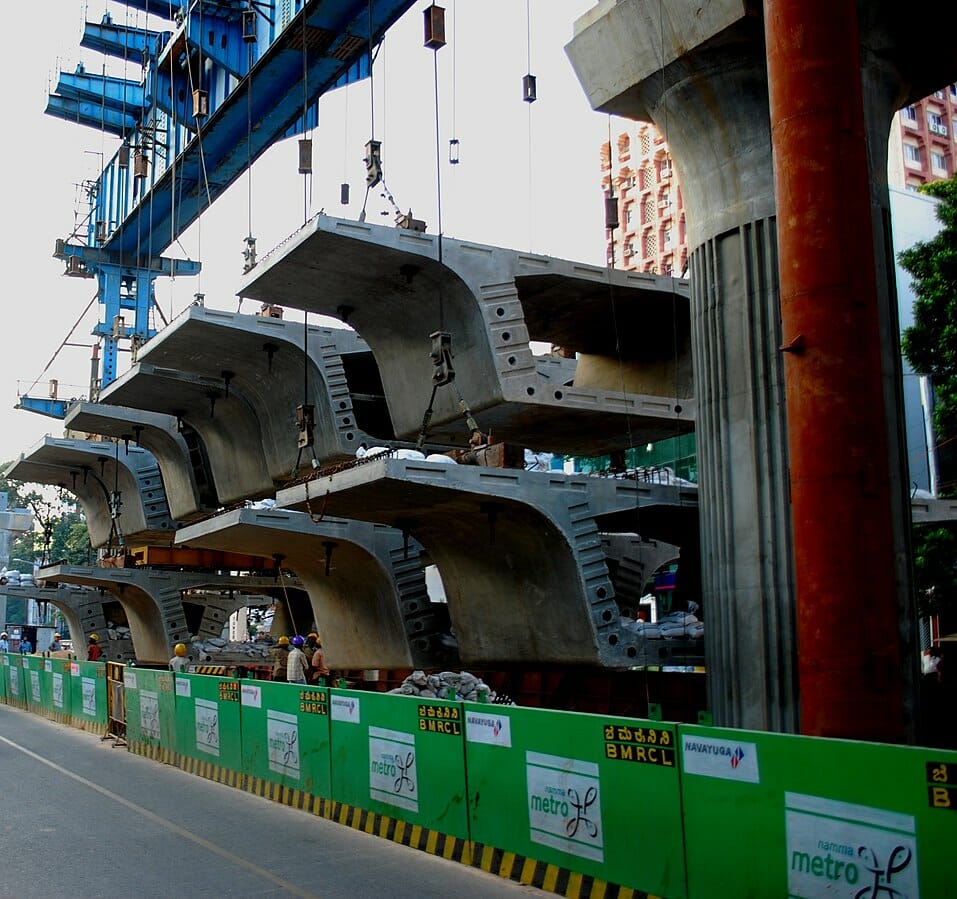Acquiring private land and property for major infrastructure projects like the Bengaluru metro has always been controversial. Especially the amount and manner of compensation to those whose land/property is acquired. Various laws and court verdicts have laid down norms for such acquisition. But the Bengaluru Metro Rail Corporation (BMRCL) has drafted its own rules on this issue, as it speeds up work on Phase 2, or what it calls the Blue Line, a 57-km stretch that connects Central Silk Board to Kempegowda International Airport (KIA) via KR Puram.
Slated to be completed in 2024, this project linking the Outer Ring Road to the airport received the Union Cabinet’s approval in 2020. It has been divided into two phases: Phase 2A from Central Silk Board to KR Puram with 13 stations and Phase 2B (KR Puram to KIA) with 17 stations along its 38-km route on the Outer Ring Road.
The routes planned required the acquisition of private land/property. Which raises the questions: How does the BMRCL acquire this land and what options and/or compensation are offered to the affected households?

Social Impact Assessment
The Environmental Impact Assessments (EIA) for Phase 2A and Phase 2B were formulated by the Asia Development Bank in 2020, as mandated by the EIA 2011 notification for all new projects before they seek environmental clearances. This was following the loan agreement signed between BMRCL and ADB in August that year for the completion of these key routes.
As per the Draft Resettlement Plan prepared for this metro corridor, the corporation has its own policy framework in the form of the BMRCL Compensation and Resettlement Package 2019, which acts as a guiding principle in providing assistance or paying compensation to resettled families.
For its effective implementation, BMRCL surveyed households that would be affected by the project and prepared an assessment to gauge the number of economic enterprises and the common property resources held by these households.
At this stage, BMRCL officials conducted 20-30 minute interviews with Project Affected Families (PAFs) to identify and assess social and economic impact issues and propose cost-effective mitigation measures.
Land acquisition and rehabilitation
“We generally select as many vacant lands as possible as this is conducive for constructing metro stations,” says Chennappa Gowda, BMRCL’s general manager (land acquisition). “If this is not possible, we choose lands with less share of built-in structures and avoid multi-storey buildings altogether”.
The plan says that the viaducts are planned on the existing median or the adjoining service road so that minimum land acquisition is required. For phase 2B, BMRCL figures show that 579 people across 189 households have been affected. Of these, 215 households were affected economically which deserved direct monetary compensation while 200 households would be displaced.

Those displaced are eligible for rehabilitation and resettlement while those whose incomes were disrupted are only eligible for compensation and accompanied allowances. These households are also profiled based on their socio-economic location based on the surveys and interviews carried out by BMRCL.
Read more: What can residents affected by Namma Metro land acquisition get?
“During Phase 1 of Namma Metro, we rehabilitated Basaweshwara slum settlement near the city railway station at independent houses in Srigandha Kaval near Annapurneshwari Nagar,” says Chennappa.
Another settlement near Sampige theatre, Malleshwaram were given new homes in Peenya. For Phase 2, he says only 10 low-income households near JD (Jedi) Mara were affected, for whom houses have been purchased by the BMRCL near Haralur. According to Chennappa, all the households in these areas have services like electricity supply, sanitation, drinking water etc.
The rehabilitation and resettlement award payable to the affected families is inclusive of a one-time subsistence allowance and transportation allowance, payment for cattle sheds and petty shops and details of mandatory employment to be provided to members of the affected families.
Compensation details
Chennappa says the BMRCL provides alternative housing only for residents living in temporary or informal settlements. Tenants or homeowners affected by the metro project would be compensated accordingly, i.e as per the current market value or higher, depending on their assessment.
Given below are the rates as furnished in the 2021 Supplementary Resettlement Action plan for Lakkasandra Squatters (Residential squatters are defined as people living in unused buildings without a legal right):
Owners losing only land
- Consent Award based on the mutually agreed market value of land and structures
- Shifting allowance
- Upto 1000 sq ft – Rs 25,000
- 1001 sq ft – 1500 sq ft – Rs 30,000
- 1501 sq ft –Rs 35,000
- Inconvenience allowance- one-time payment of Rs 70,000
- Transitional Allowance
- Upto 1000 sq ft – Rs 1,35,000
- 1001 sq ft – 1500 sq ft – Rs1,70,000
- More than 1501 sq ft – Rs 2,05,000
Owner losing land and commercial structure totally (owner operating own business in the acquired premises)
- Shifting allowance remains the same
- Business loss allowance
- Average payment of SGST upto Rs 5000 per month – Allowance Rs 85,000
- Average payment of SGST between Rs 5001 to Rs 15,000 per month – Allowance Rs 1,70,000
- Average payment of SGST above Rs 15001 per month – Allowance Rs 2,25,000
- If without SGST documentation – Allowance Rs 60,000
Tenant, for residential purposes
- Shifting allowance per tenant single/family: Rs 30,000
- Inconvenience Allowance Rs 70,000 per tenant family and Rs 35,000 for single tenant.
- Cost of structure based on a valuation by PWD and without deducting depreciation cost
- Subsistence Allowance Rs 30,000.
Slum Dwellers
Slum dwellers’ families residing in declared slums will get Rs 5,00,000 as a housing support grant.
Vulnerable Project Affected Families (PAFs)
Over and above other eligible entitlements, displaced title holder families belonging to the Scheduled Castes and Scheduled Tribes or other vulnerable groups shall receive an additional Rs 50,000. These are only some of the criteria listed in the supplementary resettlement plan, which has an exhaustive list aimed at covering all kinds of living and commercial engagements. The full plan can be accessed here.
Namma metro only bothers about there work without thinking about pedestrian ,footpath,unfilled pits and roads and rain water drain etc even after years of completion of project